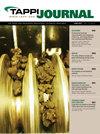氧化石墨烯纳滤膜片和管对牛皮纸黑液浓缩的横流分离特性及试验研究
IF 0.6
4区 农林科学
Q4 MATERIALS SCIENCE, PAPER & WOOD
引用次数: 0
摘要
硫酸盐循环中弱黑液的蒸发脱水是一个高能耗的过程。膜是一种有吸引力的节能脱水替代方案,但现有的商用聚合物或陶瓷膜要么在BL中降解,要么成本很高。我们最近的工作已经证明了氧化石墨烯(GO)纳滤膜的工程,它们在BL条件下的稳定性和有前途的性能,并初步扩大到片状和管状。在这里,我们详细描述了真实BL条件下和横流操作下氧化石墨烯膜片和管的分离特性。氧化石墨烯管状膜的循环模式试验显示,平均“生产通量”为16 L/m2/h (LMH),木质素(98.3%)、总固体(66%)和总有机碳(83%)的废品率很高,没有发现不可逆污染的迹象。在牛皮纸厂的滑流试验中,使用总固体含量为~16 wt%的WBL,相应的氧化石墨烯片膜产生了~25 LMH的平均通量,并保持了~97%的高木质素去除率。最后,我们试验了陶氏/杜邦XUS1808聚酰胺复合反渗透(RO)膜,用于氧化石墨烯纳滤膜渗透的最后一英里处理。该反渗透膜在65 bar下的稳态通量为19 LMH,产生的TS水含量为~0.02 wt%,非常适合在硫酸盐工艺的纸浆洗涤操作中重复使用。该结果对氧化石墨烯膜在BL浓度和其他相关应用中的工业应用具有很强的积极意义。本文章由计算机程序翻译,如有差异,请以英文原文为准。
Cross-flow separation characteristics and piloting of graphene oxide nanofiltration membrane sheets and tubes for kraft black liquor concentration
Dewatering of weak black liquor (WBL) in the kraft cycle by evaporation is highly energy intensive. Membranes are an attractive alternative for energy-efficient dewatering, but existing commercial polymeric or ceramic membranes are either degraded in BL or have high capital costs. Our recent works have demonstrated the engineering of graphene oxide (GO) nanofiltration membranes, their stability and promising performance in BL conditions, and preliminary scale-up into sheets and tubes. Here, we describe in detail the separation characteristics of GO membrane sheets and tubes under real BL conditions and crossflow operation. Recycle-mode piloting of a GO tubular membrane showed average “production flux” of 16 L/m2/h (LMH) and high rejections of lignin (98.3%), total solids (66%), and total organic carbon (83%), with no signs of irreversible fouling identified. A corresponding GO sheet membrane produced an average flux of ~25 LMH and maintained high lignin rejection of ~97% during a slipstream pilot at a kraft mill site using WBL with ~16 wt% total solids (TS). Finally, we piloted a Dow/DuPont XUS1808 polyamide composite reverse osmosis (RO) membrane for last-mile processing of the GO nanofiltration membrane permeate. The RO membrane showed a steady state flux of 19 LMH at 65 bar and produced ~0.02 wt% TS water product, which is highly suitable for reuse in pulp washing operations in the kraft process. The results have strong positive implications for the industrial application of GO membranes in BL concentration and other related applications.
求助全文
通过发布文献求助,成功后即可免费获取论文全文。
去求助
来源期刊

Tappi Journal
工程技术-材料科学:纸与木材
CiteScore
1.30
自引率
16.70%
发文量
59
审稿时长
6-12 weeks
期刊介绍:
An internationally recognized technical publication for over 60 years, TAPPI Journal (TJ) publishes the latest and most relevant research on the forest products and related industries. A stringent peer-review process and distinguished editorial board of academic and industry experts set TAPPI Journal apart as a reliable source for impactful basic and applied research and technical reviews.
Available at no charge to TAPPI members, each issue of TAPPI Journal features research in pulp, paper, packaging, tissue, nonwovens, converting, bioenergy, nanotechnology or other innovative cellulosic-based products and technologies. Publishing in TAPPI Journal delivers your research to a global audience of colleagues, peers and employers.
 求助内容:
求助内容: 应助结果提醒方式:
应助结果提醒方式:


